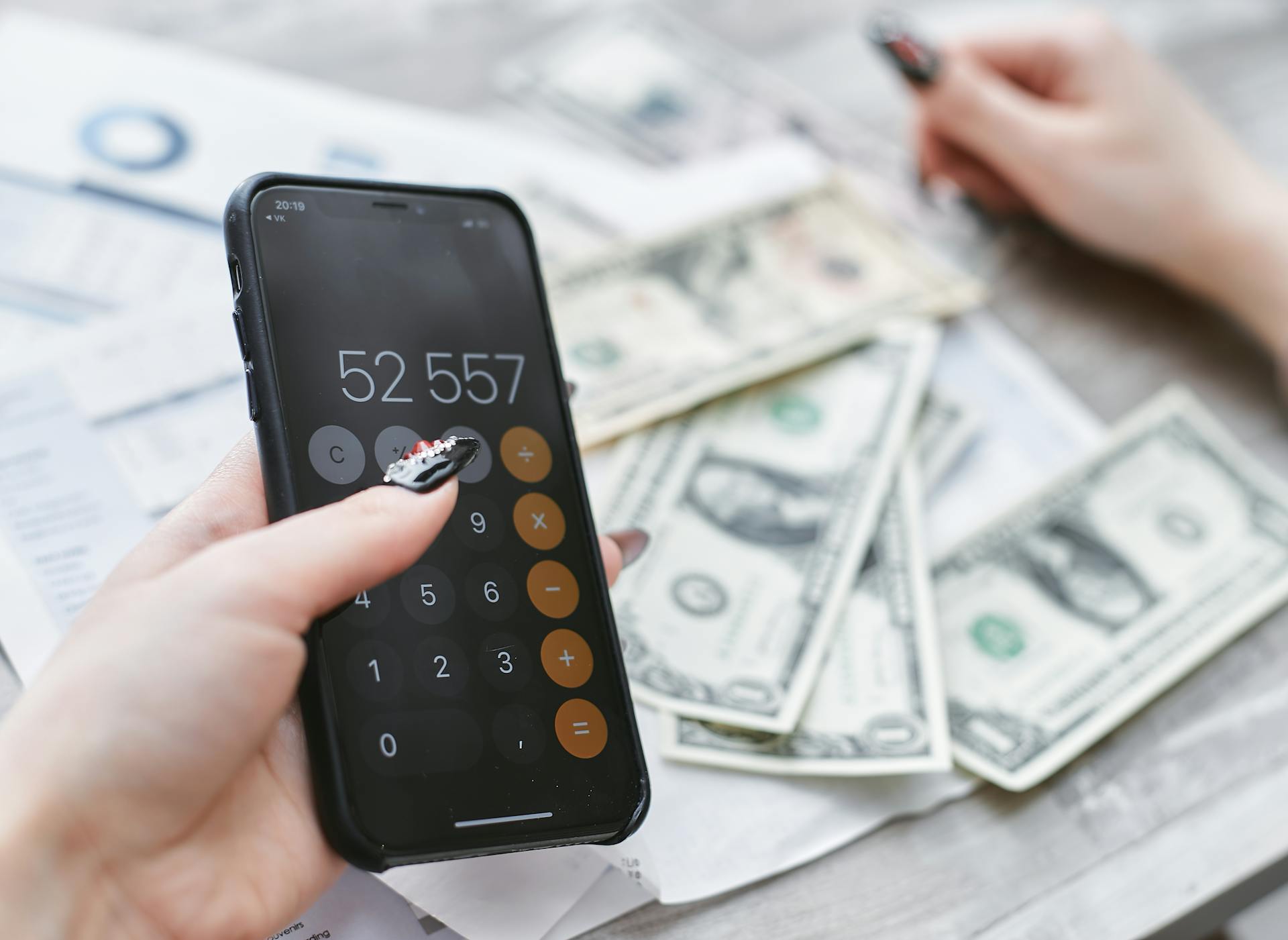
The Aussie dollar is a dynamic and ever-changing currency, influenced by a range of factors.
The Reserve Bank of Australia (RBA) plays a significant role in setting interest rates, which in turn affects the Aussie dollar's exchange rate. The RBA's decisions can have a ripple effect on the economy.
The Australian economy is heavily reliant on exports, particularly commodities such as iron ore and coal. A strong global demand for these resources can drive up the Aussie dollar's value.
The country's close trade relationship with China, its largest trading partner, also has a significant impact on the Aussie dollar's exchange rate. China's economic growth and trade policies can either boost or weaken the Aussie dollar.
Recommended read: Cad to Aussie Dollar
Exchange Rate and Value
The Australian dollar is a popular currency among traders due to its high interest rates, relatively free foreign exchange market, and stable economy. It's also seen as a diversification benefit in a portfolio containing major world currencies.
The Aussie dollar's value is heavily influenced by commodity prices, which means its exchange rate tends to move in the opposite direction of other reserve currencies. This is because Australia's economy is driven by commodity exports, such as minerals and agricultural products.
The Australian dollar is a reserve currency, and its popularity can be attributed to its relative lack of central bank intervention and general stability of the economy and government. In fact, the Central Bank of Russia has even announced that it would begin keeping Australian dollar reserves.
Here's a breakdown of the top 10 most traded currencies in the world, based on the latest data:
The Australian dollar's relatively stable economy and government have contributed to its popularity among traders.
Australian Dollar in Australia
The Australian dollar is a widely accepted currency throughout Australia, thanks to the Reserve Bank Act 1959. Australian notes are legal tender without an amount limit.
However, when it comes to coins, there are some restrictions. Coins intended for general circulation are legal tender, but only for specific amounts. For example, 1c and 2c coins are still legal tender, but only for payments not exceeding 20c.
Here's a breakdown of the maximum amounts for which you can use each coin denomination:
- 1c and 2c coins: 20c
- 5c, 10c, 20c, and 50c coins: $5
- $1 coins: $10
- $2 coins: $20
- Non-circulating $10 coins: $100
- Coins of other denominations: no lower limit
It's worth noting that while these coins are technically legal tender, businesses don't always have to accept them. However, if a business refuses to accept cash, you might be able to take them to court, although this is usually not a viable option for consumers.
Adoption of the
The Australian dollar was first introduced in 1966, replacing the pound at a conversion rate of A$2 = A£1.
In February 1966, the Australian government replaced the pound with the dollar.
The new currency was modelled on South Africa's replacement of the South African pound with the rand, which was worth 10 shillings or 1⁄2 pound.
Recommended read: Gbp Currency News
The conversion rate was not a simple 1:1 swap, with a pre-decimal amount of nine pounds, sixteen shillings and sixpence becoming $19.65 in terms of dollars and cents.
The Australian dollar was pegged to the pound sterling at a rate of A$1 = 8s sterling.
However, this peg was short-lived, as the pound sterling was devalued against the US dollar in 1967, prompting Australia to peg its currency to the US dollar instead.
This change allowed the Australian dollar to appreciate in value versus sterling.
Readers also liked: 1100 Australian Dollars to Us Dollars
Commemorative Coins
Commemorative coins are a great way to celebrate significant events and milestones in Australia's history. The Royal Australian Mint has been producing high-quality numismatic coins since 1970.
The first commemorative 50-cent coin was issued in 1970, marking James Cook's exploration along the east coast of the Australian continent. This was followed by a coin commemorating Queen Elizabeth II's Silver Jubilee in 1977.
In the 1980s, the mint continued to produce commemorative coins, including one for the Brisbane Commonwealth Games in 1982 and the Australian Bicentenary in 1988. These coins not only showcase the country's rich history but also make for a great addition to any coin collection.
Explore further: History of Australian Currency
The 1990s and 2000s saw a significant increase in the number of commemorative coins issued, catering to the growing demand from collectors. These coins feature a wide range of designs, including ones for the 40th anniversary of decimal currency in 2006.
One notable example is the 2006 mint proof and uncirculated sets, which included one- and two-cent coins. Another interesting example is the introduction of Australia's first triangular coin in early 2013, marking the 25th anniversary of the opening of Parliament House.
Within Australia
Within Australia, Australian notes are legal tender without an amount limit, thanks to section 36(1) of the Reserve Bank Act 1959. This means you can use them to make any purchase you like.
However, there are some limitations on the use of Australian coins. For example, 1c and 2c coins, which were withdrawn from circulation in 1992, are still technically legal tender, but only for payments not exceeding 20c. This might seem a bit silly, but it's worth knowing if you're trying to make a purchase with these coins.
Australian coins of other denominations, such as 5c, 10c, 20c, and 50c, can be used for payments up to $5. $1 coins and $2 coins have slightly higher limits, at $10 and $20 respectively. Non-circulating $10 coins, on the other hand, can be used for payments up to $100.
Here's a quick rundown of the limits for each type of coin:
- 1c and 2c coins: for payments not exceeding 20c
- 5c, 10c, 20c, and 50c: for payments not exceeding $5
- $1 coins: for payments not exceeding $10
- $2 coins: for payments not exceeding $20
- Non-circulating $10 coins: for payments not exceeding $100
- Coins of other denominations: no lower limit
It's worth noting that just because coins are legal tender, it doesn't mean businesses are obligated to accept them. In fact, the Reserve Bank says businesses can set their own commercial terms for transactions.
Explanatory Notes and Data
The Aussie dollar has a rich history, and understanding its evolution is key to grasping its current value. In 1966, the Australian pound was replaced by the Australian dollar, with a ratio of 2 dollars to 1 pound.
Decimalization brought about significant changes to the currency, including the introduction of coins and banknotes. The Australian dollar was the standard currency for Australia, Christmas Island, Cocos Islands, Norfolk Island, Nauru, Kiribati, and Tuvalu.
The Australian dollar was also the currency of Papua New Guinea from 1966 to 1975, before being replaced by the Papua New Guinean kina at par. Similarly, it was the currency of the Solomon Islands from 1966 to 1977, before being replaced by the Solomon Islands dollar at par.
Here's a brief timeline of the Australian dollar's predecessors and successors:
Understanding the Aussie dollar's history can help you make informed decisions about your finances.
Economic Factors
The Australian dollar is a popular currency among traders due to its high interest rates and relatively low government intervention in the foreign exchange market. This makes it an attractive option for investors looking to diversify their portfolios.
The Australian economy is known for its stability and strong commodity prices, which are the dominant drivers of the Aussie dollar. This means that the currency tends to rally during global booms and fall during recessions.
One of the key factors that sets the Australian dollar apart from other currencies is its exposure to Asian economies and the commodities cycle. This makes it a popular choice for traders looking to gain exposure to these growing markets.
The Reserve Bank of Australia's (RBA) independent monetary policy also contributes to the Aussie dollar's popularity. Unlike some other central banks, the RBA is not required to intervene in the foreign exchange market, allowing the currency to float freely.
Here are some key statistics on the Australian dollar's performance in the global foreign exchange market:
As you can see, the Australian dollar remains a significant player in the global foreign exchange market, with a consistent ranking over the past few years.
Frequently Asked Questions
Is it a good time to buy Australian dollars?
There is no guaranteed "good" time to buy Australian dollars due to the unpredictable nature of currency markets. Check current exchange rates and consider your financial goals to make an informed decision.
What is the Australian dollar update today?
The current exchange rate for Australian dollars to US dollars is 0.623, with a 0.153% change from yesterday. The Australian dollar has remained relatively stable over the past week, with a -0.304% decrease compared to 7 days ago.
Why is the AUD climbing?
The AUD is climbing due to a weaker US dollar and rising Australian government bond yields. Market optimism ahead of the RBA's policy decision is also contributing to its upward trend.
Is the AUD going to get stronger?
Yes, some major banks predict a slight but steady increase in the Australian dollar exchange rate for the second half of 2024 and into 2025. This could make the AUD stronger, potentially reaching 70 US cents by Q1 2025.
Sources
- https://en.wikipedia.org/wiki/Australian_dollar
- https://www.rba.gov.au/education/resources/explainers/drivers-of-the-aud-exchange-rate.html
- https://www.abc.net.au/news/2024-12-24/australian-dollar-china-trump-interest-rates/104749520
- https://www.ig.com/au/forex/markets-forex/aud-usd
- https://www.forbes.com/advisor/au/investing/currencies/aud-to-usd-forecast-and-trends/
Featured Images: pexels.com


